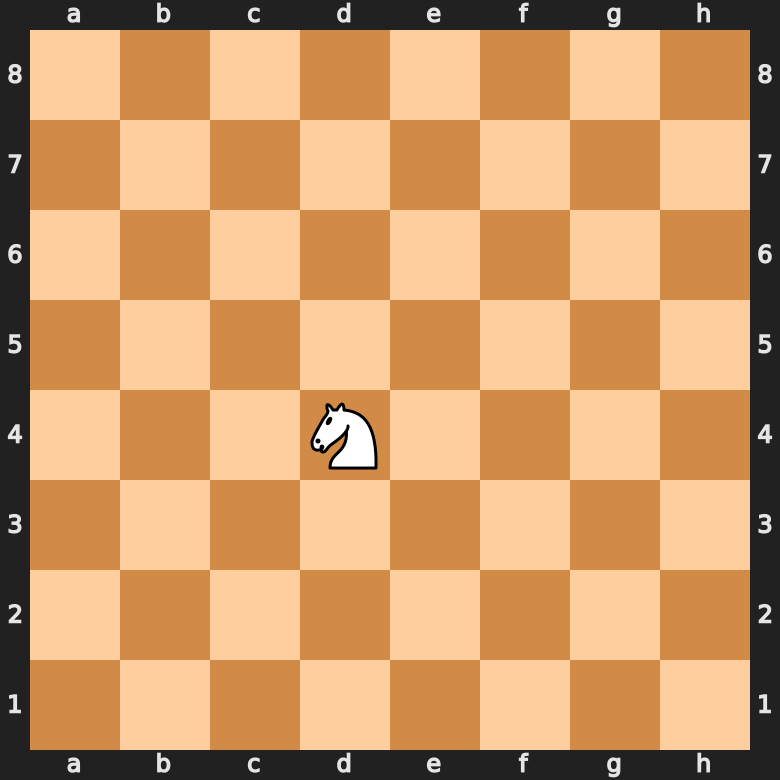How Does The Knight Move In Chess?
The knight is arguably the chess piece with the most unconventional movement pattern of them all. Before you can master the king’s game, you’ll have to learn the abilities and movement of all the pieces. So, in this guide, we’ll have a closer look at how exactly the knight moves on the chess board. Let’s start!
Knights Move in an “L-Shape”
The rules of chess allow the knight to move in a very distinct way, often called the “L-Shape” or “L-Pattern”. Why is that?
The knight can move either two squares in a horizontal direction, followed by one square in a vertical direction, or two squares in a vertical direction, followed by one square in a horizontal direction.
This sounds horribly complicated, but really isn’t. Have a look at this animation and see, if you can spot the distinct L-shape and match the knights movement with the explanation above:

This is how a knight moves along an empty chess board. However, the knight has another trick up its sleeve: jumping over other pieces. Let’s go into detail.
Knights Can Jump Over Other Pieces
The knight is the only piece that can jump over other pieces. Because of this special ability, the knight behaves quite differently in battle, compared to all other pieces. Here you can see the knight jumping over other pieces in action:

As you might have guessed, that makes the knight the only piece, besides the pawns, that can make the first move in a game of chess.
How Does The Knight Attack in Chess?
Since the knight can jump over other pieces, it only attacks the exact squares it can jump to, not the ones in between. This is in contrast to pieces like the rook, bishop, or queen. These three attack all squares between their current position and the furthest square they can move to.
Just like all other pieces (except the pawn), the knight also attacks in the same way it moves across the chess board. Meaning, each square the knight could move to within the next move is being attacked by it.

In this example you can see a knight attacking two enemy rooks in a fork.
Knights Love Attacking With Forks
Knights are notorious for forking pieces, meaning they attack two (or more) enemy pieces at once, making it impossible for the opponent to defend them all. Forks are powerful strategic attacking tools, as they are often hard to spot, especially for beginners.
The Knights Movement is Hard to Calculate
The knight can be a deadly attacking piece, even more so if your opponent is in time trouble. As said, the knight is known for its excellent forking abilities, which really come into play once your opponent lacks the time to calculate all of your knight’s moves. So, be on the look out for nifty knight forks during endgames!
Limits To The Knight’s Movement
As with all chess pieces, the knight also faces some restrictions on what it can do on the chess board. We split this section up into moves that chess pieces are not allowed to do altogether, and moves that are forbidden for the knight in particular.
Moves Chess Pieces Can’t Do In General:
- The knight can’t move “half squares”. This might seem redundant to advanced players; however it is important to mention to beginners. Knights – as well as all other chess pieces – are not allowed to move half squares (or 1.5, 2.5 etc.). A knight-move is only finished once the knight is firmly placed on a single square.
- The knight can’t share squares with other pieces (enemy or friendly). Another limitation the knight (and every other piece) is, that is has to stand on a square on its own. For example, it is not possible for a knight and a king to share a place on the chess board. This applies to both enemy pieces (that need to be captured) and friendly pieces (which block access to a certain square).
Moves The Knight in Particular Can’t Do:
- The knight can’t move in a straight line. Most chess pieces (actually, all except for the knight) only move in straight lines. The knight is not allowed to move in a straight line across the chess board; rather, it forms the distinct L-shape with its movement.
- The knight can’t move diagonally. Just as the knight is not allowed to move in a straight line, it is also not allowed to move diagonally (ok, fair, a diagonal is also a straight line).

